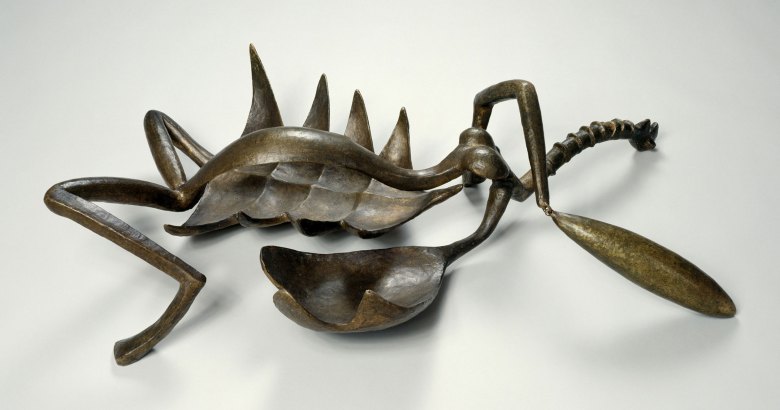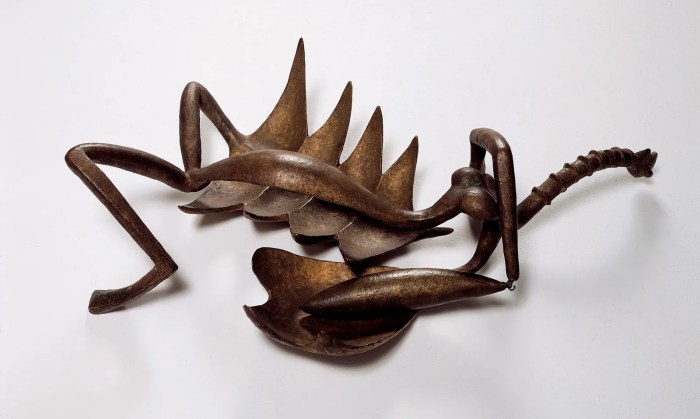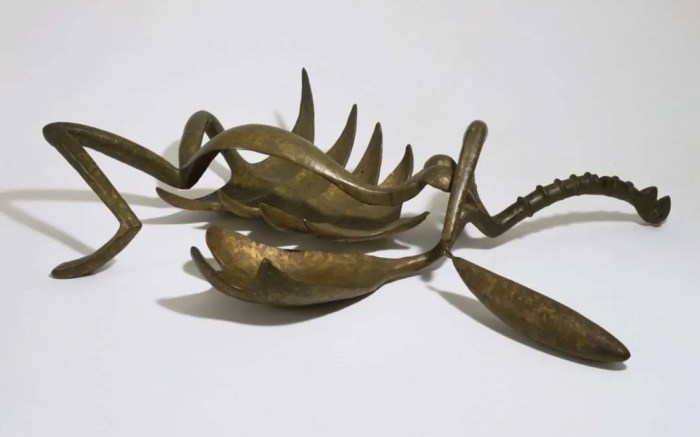Giacometti woman with her throat cut – Giacometti’s “Woman with her Throat Cut” is a haunting and enigmatic sculpture that confronts the depths of human vulnerability and inner turmoil. Through its elongated form, rough texture, and severed throat, the work embodies the existential angst and psychological complexities of the post-war era.
Giacometti’s unique approach to sculpting, influenced by existentialism, explored the fragility and isolation of the human condition. The sculpture’s elongated form conveys a sense of vulnerability and instability, while its rough surface texture evokes a sense of decay and mortality.
Giacometti’s Artistic Context

Giacometti’s unique approach to sculpting emerged in the post-war artistic climate, marked by existentialist philosophy and the search for meaning in a world shattered by conflict. His exploration of existentialism is evident in his elongated, emaciated figures, which evoke a sense of isolation, vulnerability, and the human condition.
Existentialist Influences
Existentialism emphasizes the individual’s freedom and responsibility in creating meaning in life. Giacometti’s sculptures embody this philosophy through their solitary presence and their suggestion of struggle and resilience. His figures are often depicted walking or standing alone, evoking a sense of alienation and the search for purpose.
Post-War Artistic Climate
The post-war period was a time of artistic experimentation and the emergence of new movements. Giacometti’s work was influenced by the surrealist movement, particularly its exploration of the subconscious and the irrational. However, he rejected surrealism’s emphasis on automatism, instead focusing on the conscious creation of his sculptures.
Symbolism and Meaning: Giacometti Woman With Her Throat Cut
The “Woman with her Throat Cut” embodies the fragility and vulnerability of human existence. Its severed throat represents the rawness of inner turmoil, the silent scream of anguish and despair. The sculpture evokes a sense of deep emotional distress, as if the woman’s life has been extinguished before its time.
Psychological Implications
The severed throat symbolizes the silencing of the individual, the inability to express one’s emotions or desires. It suggests a profound psychological trauma that has left an unhealed wound, a permanent scar on the psyche. The woman’s vulnerability is further emphasized by her lack of clothing, exposing her body and making her appear defenseless and unprotected.
Formal Analysis
Giacometti’s Woman with Her Throat Cutis characterized by its elongated form and rough surface texture. The sculpture stands at over six feet tall, with a slender body and attenuated limbs. The surface of the sculpture is covered in a network of deep incisions, which create a sense of tension and unease.
These formal elements contribute to the emotional impact of the work. The elongated form of the sculpture suggests a sense of vulnerability and fragility, while the rough surface texture evokes a sense of pain and suffering. The incisions across the woman’s body further emphasize the violence and trauma that she has experienced.
Elongated Form
The elongated form of the sculpture creates a sense of unease and discomfort. The woman’s body is stretched and distorted, which suggests that she has been subjected to extreme physical and emotional pain. The elongation of her limbs also makes her appear more vulnerable and fragile, which further emphasizes her suffering.
Rough Surface Texture, Giacometti woman with her throat cut
The rough surface texture of the sculpture adds to the sense of pain and suffering that is conveyed by the work. The incisions across the woman’s body are deep and jagged, which suggests that she has been subjected to a great deal of violence.
The rough texture of the surface also makes it difficult to look at the sculpture for extended periods of time, which further emphasizes the discomfort and unease that it evokes.
Historical Context

Alberto Giacometti created “Woman with her Throat Cut” in 1932, a period marked by significant social and political upheaval in Europe. The global economic crisis of the Great Depression had devastating effects, leading to widespread unemployment, poverty, and social unrest.
In the wake of World War I, Europe was still grappling with the psychological and emotional scars of the conflict. The rise of totalitarian regimes, such as Nazism in Germany and Fascism in Italy, fueled political tensions and heightened fears of war.
Social and Political Influences
The social and political turmoil of the time likely influenced Giacometti’s choice of subject matter for “Woman with her Throat Cut.” The work reflects the artist’s anxieties about the violence and suffering that were prevalent in society. The mutilated figure represents the fragility of human life and the horrors that can be inflicted upon it.
The artist’s own experiences during the war may have also shaped the work’s imagery. Giacometti served in the Swiss army during World War I, where he witnessed the devastation and brutality of combat. These experiences may have left a lasting impact on his psyche and influenced his artistic expression.
Influence and Legacy

Giacometti’s “Woman with her Throat Cut” has had a profound impact on contemporary art and culture. Its stark and haunting imagery has resonated with artists and viewers alike, inspiring numerous interpretations and reimaginings.
Influence on Contemporary Art
Giacometti’s work has influenced a wide range of contemporary artists, including Francis Bacon, Jean Dubuffet, and Anselm Kiefer. These artists have been drawn to the existential themes explored in “Woman with her Throat Cut,” as well as its innovative use of form and materials.
Bacon, in particular, was influenced by Giacometti’s exploration of the human figure in states of extreme emotion and vulnerability.
Legacy in Art History
“Woman with her Throat Cut” is considered a masterpiece of 20th-century art and has been exhibited in major museums around the world. It has been praised for its technical brilliance and its ability to evoke a profound emotional response. The work has also been the subject of numerous scholarly studies, which have explored its psychological, philosophical, and art historical significance.
Comparative Analysis

Giacometti’s “Woman with her Throat Cut” shares striking similarities with his other iconic work, “The Walking Man.” Both sculptures exhibit the artist’s characteristic elongated, attenuated figures that evoke a sense of fragility and vulnerability.
Style and Form
In terms of style, both works employ a similar technique of reducing the human form to its essential lines and shapes. The figures are rendered with rough, textured surfaces, giving them a raw and unfinished appearance. This approach emphasizes the physicality and vulnerability of the human body.
Theme and Emotional Impact
Thematically, both sculptures explore the existential themes of isolation and alienation. “Woman with her Throat Cut” depicts a figure that is both physically and emotionally wounded, while “The Walking Man” conveys a sense of aimless wandering and uncertainty.
The emotional impact of these works is profound. The elongated figures evoke a sense of empathy and compassion for the human condition. They confront the viewer with the fragility and vulnerability of existence, reminding us of the inevitable challenges and struggles that life presents.
Differences
Despite their similarities, there are also notable differences between the two works. “Woman with her Throat Cut” is a more explicitly violent and disturbing image, while “The Walking Man” is more abstract and contemplative.
Furthermore, the gender of the figures suggests different interpretations. The female figure in “Woman with her Throat Cut” may evoke themes of violence against women, while the male figure in “The Walking Man” could represent a more universal experience of human suffering.
Expert Answers
What is the significance of the severed throat in Giacometti’s “Woman with her Throat Cut”?
The severed throat symbolizes the vulnerability and fragility of human existence. It represents the psychological turmoil and inner anguish that can lead to self-destruction or a sense of emptiness.
How does the sculpture’s elongated form contribute to its emotional impact?
The elongated form conveys a sense of instability and vulnerability. It suggests a figure that is stretched beyond its limits, both physically and emotionally, evoking a feeling of existential angst.